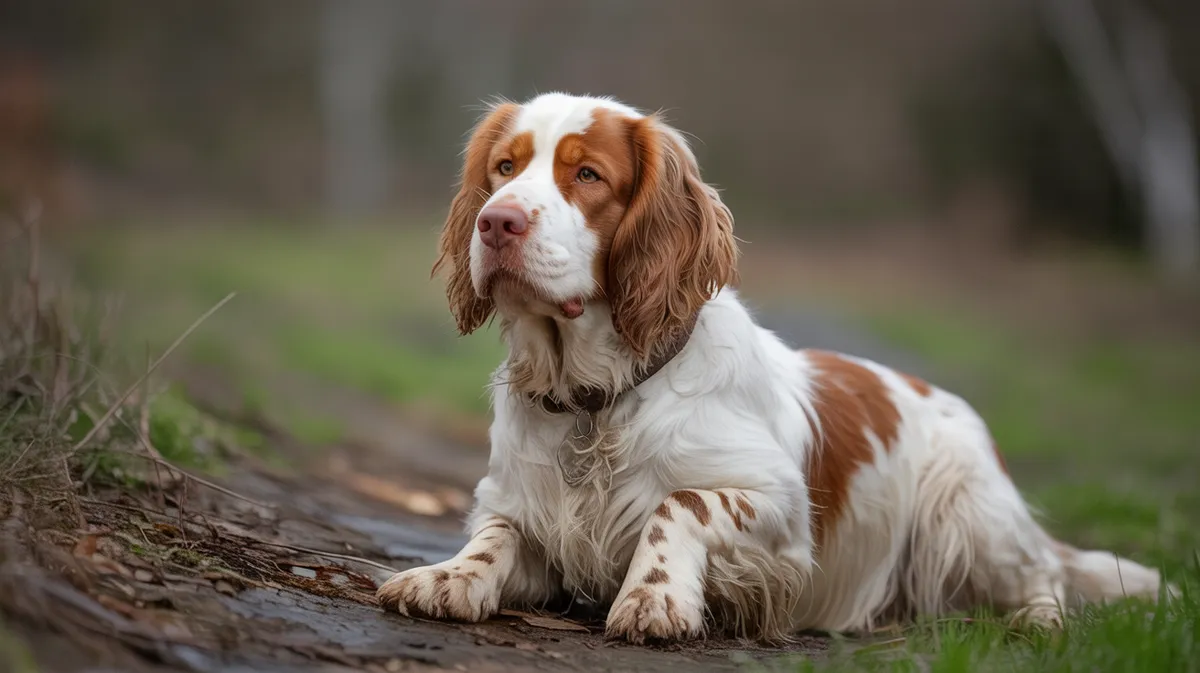
Clumber Spaniel
Canis lupus familiaris

Meet the Clumber Spaniel
The Clumber Spaniel is a large, heavy-boned breed of spaniel known for its gentle temperament and distinctive, lush white coat with lemon or orange markings. Originally bred in England for flushing and retrieving game in dense cover, this breed is characterized by its deep chest, broad head, and soulful, expressive eyes. Clumber Spaniels are affectionate, loyal companions that bond closely with families and exhibit a calm, dignified demeanor. Despite their slow, rolling gait, they are surprisingly strong and persistent workers in the field. Their amiable nature and adaptability also make them excellent pets for both active and more relaxed households.
Classification
Mammal
Habitat
Domestic; often associated with woodlands and estates for hunting
Diet
Omnivore
Lifespan
10-12 years
Conservation
Least Concern
Weight
25-39 kg (55-85 lbs)
📖Fascinating Facts
Royal Companions
Clumber Spaniels have a long history with British royalty, notably favored by Prince Albert and King Edward VII.
Exceptional Nose
They are renowned for their excellent sense of smell, which helps them excel at tracking and flushing game.
Field Specialists
Originally bred for navigating dense underbrush, Clumber Spaniels have a low, rolling gait that helps them move quietly through thick cover.
📋Detailed Description
The Clumber Spaniel is a robust, heavy-boned sporting dog, typically weighing between 25–39 kg (55–85 lbs) and standing 43–51 cm (17–20 in) at the withers. Its body is long and low-set, with a deep chest and powerful, muscular limbs adapted for endurance and strength rather than speed. The breed’s broad, square head features a pronounced occiput, well-developed flews, and large, expressive amber eyes that convey a gentle, thoughtful demeanor. The dense, straight, weather-resistant coat is predominantly white, often marked with lemon or orange patches, especially on the ears and around the eyes. Clumber Spaniels have large, pendant ears with abundant feathering, aiding in protection while moving through thick undergrowth. Their tail, traditionally docked in some countries, is carried level with the back and is well-feathered. Anatomically, they possess a strong jaw and a well-developed nose, granting them an exceptional sense of smell. The breed’s slow, rolling gait belies its stamina and ability to work tirelessly for hours in the field. Clumber Spaniels are known for their calm, affectionate disposition, forming strong bonds with family members and generally getting along well with other dogs. They are intelligent and trainable, though sometimes display an independent streak. Their social structure is typically stable, with individuals showing little aggression and preferring close companionship with humans.
💡 Did you know?
The Clumber Spaniel is named after Clumber Park in Nottinghamshire, England, where the breed was developed in the 18th century.
🔬Research & Sources
Wikipedia Summary
The Clumber Spaniel is a breed of dog of the spaniel type, developed in the United Kingdom. It is the largest of the spaniels, and comes in predominantly white with either lemon or orange markings. The name of the breed is taken from Clumber Park in Nottinghamshire where the breed was first developed. It is a gundog that specialises in hunting in heavy cover. They are gentle and loyal, and can act aloof with strangers. They have several habits which could be considered disadvantages, including a constant shedding of its coat and snoring.
Last Modified: 3/17/2025
🎭Behavior & Social Structure
Clumber Spaniels are methodical and deliberate in their movements, both in the home and the field. As gundogs, they excel at flushing and retrieving game birds from dense cover, using their powerful build to push through brambles and thick vegetation. They rely on their keen sense of smell to track and locate game, often working close to the handler in a systematic, ground-covering pattern. In domestic settings, Clumbers are generally quiet and reserved, seldom barking without cause. They are known for their gentle, tolerant nature, making them excellent companions for children and other pets. Social interactions are typically calm, and they may be aloof with strangers but rarely aggressive. Daily routines include moderate exercise, such as walks and play sessions, but they are also content to relax indoors. Clumbers can be prone to stubbornness, so consistent, positive reinforcement training is recommended. They are food-motivated, which can aid in training but also predisposes them to obesity if not managed.
👶Reproduction & Life Cycle
Clumber Spaniels reach sexual maturity between 8–12 months, though responsible breeding is recommended after 2 years of age to ensure full physical and behavioral maturity. The breed is known for relatively small litters, typically ranging from 4–6 puppies, with occasional reports of whelping difficulties due to the puppies’ large heads and broad shoulders. The gestation period averages 63 days. Females exhibit attentive maternal care, nursing and grooming their offspring for the first several weeks. Weaning begins around 3–4 weeks of age, with puppies typically ready for placement in new homes at 8–10 weeks. Breeding is generally seasonal, with most litters born in spring or early summer, although domestic dogs can breed year-round. Responsible breeders screen for hereditary conditions such as hip dysplasia, entropion, and spinal disorders, which are more prevalent in the breed.
🛡️Adaptations & Survival
Clumber Spaniels are uniquely adapted for working in dense, tangled undergrowth. Their low, elongated bodies and short, powerful legs allow them to move efficiently through brambles and heavy cover. The dense, water-resistant coat protects against thorns, moisture, and cold, while the large, well-feathered ears shield the ear canal from debris. Their broad, square muzzles and large nostrils enhance olfactory sensitivity, making them exceptional scenting dogs. The breed’s stamina and steady pace enable them to work for extended periods without tiring. Behaviorally, their calm, focused demeanor and strong bond with handlers make them reliable in the field and adaptable to various working conditions. Their gentle temperament and tolerance of other animals are likely the result of selective breeding for cooperative hunting and companionship.
📚Research Sources
🎨Cultural Significance
The Clumber Spaniel has a storied history as a favored gundog of British aristocracy, particularly during the 18th and 19th centuries. The breed was closely associated with Clumber Park, the estate of the Duke of Newcastle, and was a favorite of Prince Albert and King Edward VII. Clumbers have appeared in British art and literature as symbols of refinement, loyalty, and sporting tradition. While not prominent in mythology, their image is often linked to the English country lifestyle and the heritage of classic spaniel breeds. Today, they are valued as show dogs, therapy animals, and loyal companions, maintaining their reputation for gentleness and dependability.
🔬Recent Research & Discoveries
Recent genetic studies have focused on the Clumber Spaniel’s limited gene pool and the prevalence of hereditary diseases, emphasizing the need for outcrossing and genetic screening to maintain breed health. Ongoing research includes the mapping of breed-specific markers for hip dysplasia and intervertebral disc disease. Behavioral studies have highlighted the breed’s unique combination of independence and trainability, with implications for optimizing working and companion roles. Veterinary research has also examined the breed’s predisposition to obesity and the effectiveness of dietary and exercise interventions. The Clumber Spaniel Club of America and the UK Kennel Club are actively involved in health surveys and longitudinal studies to monitor population trends and health outcomes.
🎥Wildlife Videos

clumber spaniel Facts in the Animal world Habbits Environment and Likes
Animal planet | Discovery | Netflix | Documentary | Animal World | BBC Earth | NatGeoWild | Brave wilderness | The Dodo| Animal ...
Animal Square

Breed All About It - Clumber Spaniel
The Clumber spaniel possesses a keen hunting instinct as well as a loyal and affectionate nature.
Animal Planet

Dogs 101 Clumber Spaniel
blueeyesto082

Working Clumber Spaniel
Birch (Brackenskye Heartwood) working some grass looking for rabbits. 12th July 2018.
Hunterscliff Clumbers

Clumber Spaniel Dog Breed Pros and Cons | Clumber Spaniel Advantages and Disadvantages
We'll discuss the advantages and disadvantages of owning a Clumber Spaniel, and highlight some of the unique needs of this ...
Animal Platoon

14 Interesting Things You Should Know About Clumber Spaniel
Name Clumber Spaniel Origin Great Britain Size 50cm (20in) ...
Planet Fauna
🌍Habitat Information
The Clumber Spaniel typically inhabits Domestic; often associated with woodlands and estates for hunting environments. Clumber Spaniels have adapted to their environments with specialized features and behaviors.
Primary Habitat:
Domestic; often associated with woodlands and estates for hunting
More detailed habitat information will be available soon.
🛡️Conservation Status
The Clumber Spaniel is currently classified as Least Concern. Conservation efforts are crucial for preserving this species for future generations.
Common Threats:
- 🏠Habitat loss and fragmentation
- 🌡️Climate change impacts
- 🎯Hunting and poaching
- 🏭Human-wildlife conflict
⚠️Threats & Conservation Challenges
While the Clumber Spaniel is not considered at risk globally, it is classified as a Vulnerable Native Breed in the UK due to low annual registration numbers. The primary threats include a limited gene pool, which increases the risk of inherited health problems such as hip and elbow dysplasia, intervertebral disc disease, and entropion. Obesity is a common challenge due to the breed’s tendency toward inactivity and strong food motivation. Human impact includes reduced demand for traditional gundogs as hunting declines, and the breed’s high grooming and exercise needs can deter potential owners. Conservation challenges focus on maintaining genetic diversity and promoting responsible breeding practices. Population trends remain stable in North America but are declining in the UK and parts of Europe.
🔬Scientific Classification
Scientific Name
Canis lupus familiaris
Classification Hierarchy
🔍 About Taxonomic Classification
Taxonomic classification is a hierarchical system used by scientists to classify and organize living organisms based on shared characteristics and evolutionary relationships.
The system moves from broad categories (Kingdom) to increasingly specific ones, with each animal's scientific name typically consisting of its Genus and species.
📝Community Notes
Share your observations and insights about the Clumber Spaniel with our community of wildlife enthusiasts.
Join Our Community
Sign in to share your observations and connect with fellow wildlife enthusiasts.
Sign In to ContributeNo community notes yet
Be the first to share your observations about the Clumber Spaniel!
Explore Clumber Spaniel
Select a tab above to learn more about this amazing animal.
📸Photo Gallery
No photos available for this animal yet.
🌟Discover More Wildlife
Continue your journey of discovery with more fascinating animals from our database
